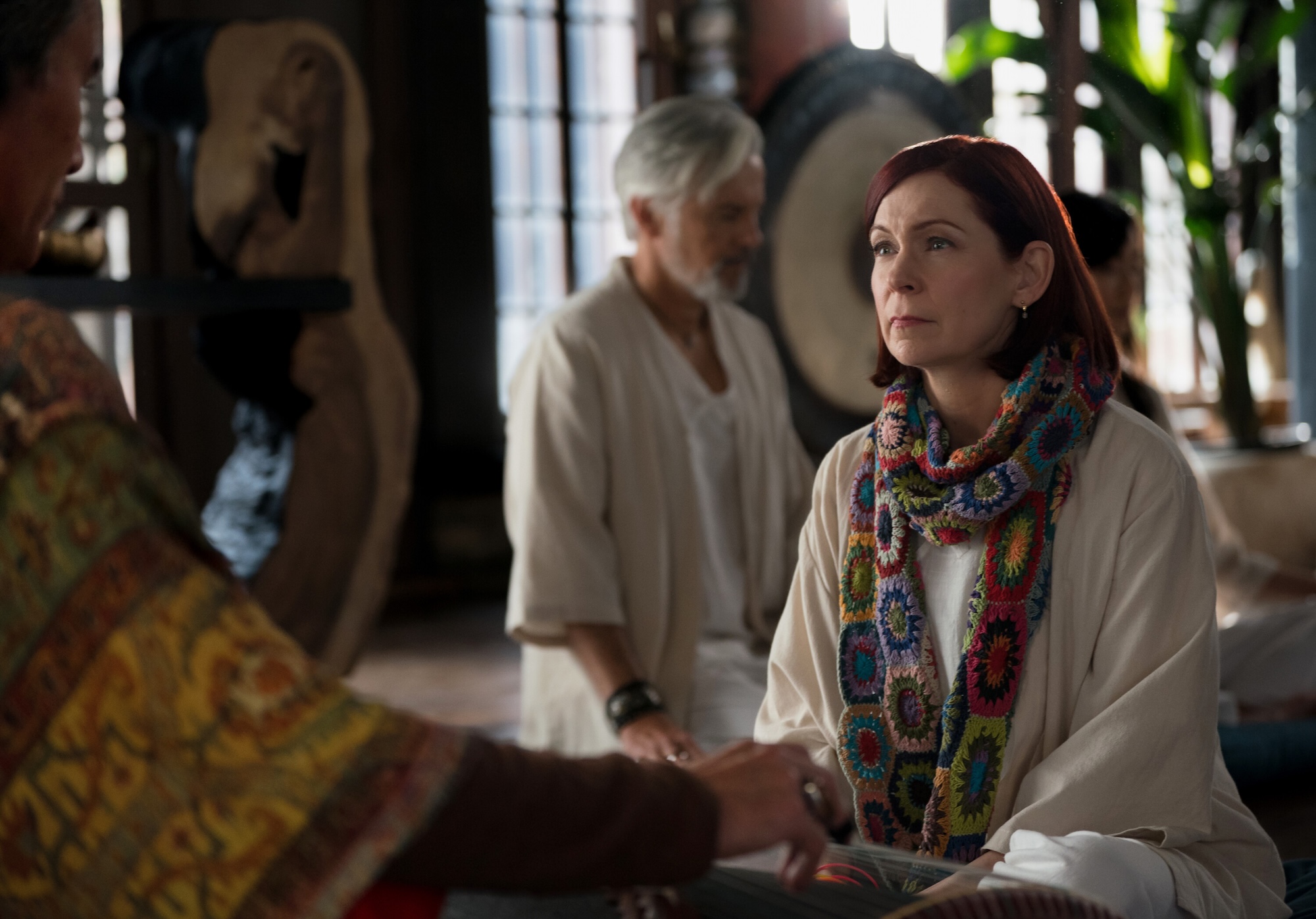The ‘Longlegs’ Hype Machine Was Almost Onto Something. Almost.
Early on in The Silence of the Lambs, intrepid FBI trainee Clarice Starling (Jodie Foster) is regaled with horror stories about the incarcerated psychiatrist whom she’s been conscripted to interview in his cell in a Baltimore mental hospital. The freakiest tale involves an implacable calm in the midst of carnage. It seems that several years earlier, the good doctor had taken a bite of a hapless nurse who’d gotten too close. “His pulse never got above 85,” recalls the facility’s head honcho, a bit too giddily. “Even when he ate her tongue.”
I thought of this sequence during Osgood Perkins’s much-anticipated new thriller, Longlegs, a serial killer saga that is thoroughly and knowingly Thomas Harris coded, beginning with its selection of protagonist: an intrepid woman federal agent tracking down an elusive predator who strews enigmatic clues in his wake. (It’s also set in the mid-1990s, concurrent with the seismic pop cultural influence of The Silence of the Lambs, which remains one of the great analog genre movies—not a cell phone in sight, just people living [and getting their faces ripped off] in the moment.) In this case, though, the mental connection to Jonathan Demme’s Oscar-winning classic wasn’t anything to do with what was happening on-screen, but instead to Longlegs’s much-discussed online marketing campaign, which may be the best of its kind since the The Blair Witch Project set the benchmark for virality 25 years ago this summer. In the most recent online teaser—the latest in a steady stream of internet breadcrumbs that includes ersatz crime-scene reports, Zodiac-style cyphers, and cryptic non sequiturs—Maika Monroe’s character comes face-to-face with the eponymous sociopath played by Nicolas Cage, with the latter’s face obscured by a censor-style black box. Meanwhile, a bit of on-screen text informs us that while shooting this scene, Monroe was so upset by her costar’s makeup job that her resting heart rate more than doubled from 76 to 170 BPM. “That was a visceral experience I’ll never forget,” Monroe is quoted as saying; in light of such behind-the-scenes information, one wonders whether Hannibal Lecter himself would be able to hold it together while watching the finished product.
There has always been an intrinsic relationship between hype and horror, which is predicated on the promise of visceral and unforgettable experiences: Think of vintage schlockmeister William Castle stationing fake nurses in a theater lobby where the 1958 shocker Macabre screened in order to tend to potentially overwhelmed ticket buyers, or the producers of Paranormal Activity using night-vision footage of screaming audience members as a seal of authenticity. Discombobulation can be a powerful promotional tool in and of itself: One of the planned (and ultimately unreleased) trailers for The Exorcist consisted of nothing more than strobe-lit images of Linda Blair’s scarred, demonic face, effectively bridging hard-sell saturation advertising with the aesthetics of the avant-garde. “We are hiding something under a veil,” Perkins recently told Polygon. “We are hiding something under a curtain and it’s more fun to pull the sheet off when there’s a lot of people watching.” If you comb through the advance reviews of Longlegs on X and the film’s Letterboxd page, you’ll see that Perkins has already amassed a legion of satisfied customers whose breathless posts include claims that the movie features “absolutely rancid, cursed vibes,” feels like “a festering wound in a spot you can’t reach,” and is “violently evil.” Exciting stuff, but there’s a difference between susceptibility and skepticism—and also between raising expectations and setting the bar impossibly high. “At this point, Longlegs is gonna have to come out of the screen and kill me himself with how you guys are talking about it,” joked one critic sarcastically. Or, to quote another enduring observation about the anxious, desirous yearning to be terrified: “If I pay $40 for a haunted house, I better die.”
To give credit where it’s due, the first 10 minutes or so of Longlegs are so effectively realized that one could be forgiven for thinking that they were watching a classic. The opening shot places us in the passenger seat of a station wagon winding its way down a country road, gazing through the front window at the grayed-out sky; before we’ve even gotten our bearings, we’re made to wonder about both the identity of the unseen driver and why we’re along for the ride. We cut to a young girl in an isolated farmhouse, watching as the same car slowly pulls up and parks in her driveway, a tableau suffused with nervous, expectant dread. From there, Perkins stages a close encounter between strangers that’s so startling—and then over so quickly—that the effect is almost subliminal. There’s an art to jump scares, and Perkins—a low-budget genre specialist leveling up in his fourth feature—shows that he understands the mechanics as well as the metaphysics; the editing suggests a movie rushing to repress its own anxious, wide-eyed subconscious.
The last time an American horror movie began so strongly was David Prior’s 2020 apocalypse-soon epic The Empty Man, whose prologue nods to the Iraq-set opening of The Exorcist and which diligently spends the rest of its inflated running time living up to its own introduction. It’s worthwhile to compare The Empty Man to Longlegs insomuch as the two films could almost be photo negatives of each other, industrially speaking: Where Perkins has benefited hugely from savvy advertising, Prior’s debut was left to die during COVID by studio executives who resented its scope and ambition. (Happily, The Empty Man has since been reclaimed as a cult item.) There are also similarities: Both movies feature an antagonist who seemingly possesses the ability to make others do their dirty work, and both owe a structural debt to the works of David Fincher, especially Se7en, which, no less than The Silence of the Lambs, unfolds as a master class in manipulating (and misdirecting) audience expectations—an inexorable exercise in convergence that transforms despair into a sort of diabolical satisfaction.
Previously, Perkins’s features were defined by a kind of stasis, most notably—and frustratingly—in 2016’s I Am the Pretty Thing That Lives in the House, an old-fashioned haunted-house chiller that’s patient to the point of paralysis. Longlegs has been designed with propulsion in mind, embracing the sort of procedural tropes perfected by Demme and Fincher and then trying to personalize them past the point of cliché. The idiosyncrasy begins with Monroe, a thoughtful, controlled actress who hasn’t so much bypassed her millennial scream-queen status as finessed it; a decade on from It Follows, she’s aged into her own particular and haunted gravitas. Even if the character of Lee Harker, a rising departmental superstar with a class-based inferiority complex and latent (absent) daddy issues, has been conceived as Clarice Starling cosplay, Monroe inhabits it with conviction; she also sells the first of Perkins’s big conceptual swings, which is that Lee’s Will Graham–ish intuition—showcased in an early set piece involving a routine door-to-door gone wrong—is possibly paranormal in origin. It’s this same ambiguous ability—somewhere between a hunch and ESP—that convinces Lee’s boss Carter (Blair Underwood) to try to track down the notorious Longlegs, whose body count over three decades is made up entirely of suburban families whose patriarchs have seemingly been compelled to mutilate their wives and children without explanation, or even evidence of an outside presence.
Like two other recent horror movies, Late Night With the Devil and MaXXXine, Longlegs plays with the history (and hysteria) around the Manson Family killings as well as the so-called Satanic panic of the early 1980s, which reflected a larger skirmish between scandalized evangelicals and secular skeptics. In leveraging stolid Middle American iconography against carefully chosen countercultural artifacts—including the repeated use of T. Rex’s 1971 hit “Bang a Gong” (“You’ve got the teeth of the hydra upon you / you’re dirty, sweet and you’re my girl”)—Perkins cinches a bold but dubious link between fire-and-brimstone scripture and glam-rock decadence. He implies that subversive gender-bending culture warriors like Marc Bolan and Lou Reed were emissaries of the same occult energy being channeled by Cage’s stringy-haired, devil-worshiping outcast—a stance that comes off weirdly (and maybe accidentally) reactionary.
It’s necessary to say a few words about Cage, whose casting is another big, conceptual swing: taking an A-list, Oscar-winning actor familiar enough to have inspired two different movies about his own celebrity and burying him under layers of mystery (and makeup). Suffice it to say that there’s probably more of Cage here than many viewers might reasonably expect, and that he cuts a formidable enough figure to justify the screen time, although not to make us forget who’s showboating behind the bulbous prosthetics. To return to The Silence of the Lambs, Anthony Hopkins’s acting endures because he disappears into Lecter’s rigorous ratio of civility to savagery; circa 1991, it was a star-making performance for a veteran more suited to self-effacement. When Cage is in nouveau-shamanic mode, he’s too ecstatic (and entertaining) to be alienating. The more time we spend watching Longlegs at work—including as a very particular sort of hands-on artisan—the more it feels like a well-intentioned but underwhelming stunt: a failed attempt at weaponizing Cage’s charisma that winds up reinforcing it, and in doing so undermines the movie’s desire to conjure up something truly diabolical in the home stretch.
To reveal too much more about Longlegs—or Longlegs—would be a disservice; there’s something to be said for the element of surprise, and Perkins surely has a few up his sleeve. What’s frustrating, though, is how the more the movie revels in its own ephemera, the more time it gives the viewer to get ahead of the story, with certain capital-R Revelations telegraphed way too far ahead of schedule. For all of Perkins’s white-knuckle directorial control—manifested mostly in his recognizably elevated use of symmetrical compositions built around a single, central focal point—the visual language quickly grows redundant, and that goes double for the muted, whispery quality of the acting outside of Monroe and Cage, delivered by the supporting performers as if they’ve been hypnotized. This tranced-out quality recalls another influential predecessor: Kiyoshi Kurosawa’s incomparable mind-fuck Cure, which examined cosmic questions of free will and complicity with exponentially more elegance.
On this note, the single creepiest conceit in Longlegs—one alluded to in the trailers but carefully slow-played in the movie—involves the use of a vintage genre archetype: the haunted, dead-eyed marionette, a figure as old-fashioned as Dead of Night and as newfangled as M3GAN (as well as the new and enjoyably tricky Irish thriller Oddity). At one point, we get the witty, shivery image of a nearly life-sized humanoid puppet splayed out for a faux-autopsy, leading to the revelation that its skull cavity has been carved out to make room for a weird metallic orb—a sly allusion to the possibilities of mind control lurking at the edges of the story (which, to Perkins’s credit, retain a sliver of ambiguity). It may well be unfair to suggest that this immaculate but inanimate object is the perfect avatar for a well-crafted but hollow movie, but as Longlegs would surely agree, it’s ultimately what’s inside that counts.
Adam Nayman is a film critic, teacher, and author based in Toronto; his book The Coen Brothers: This Book Really Ties the Films Together is available now from Abrams.







